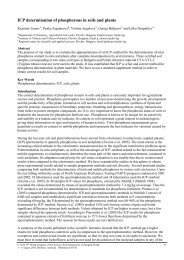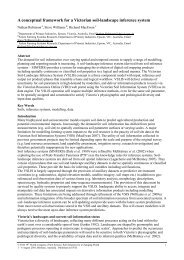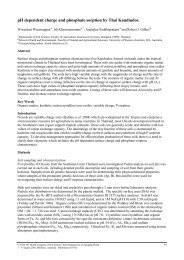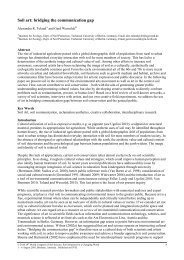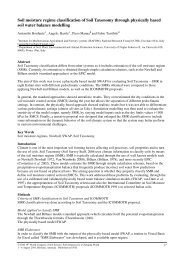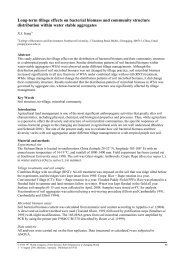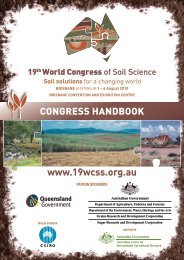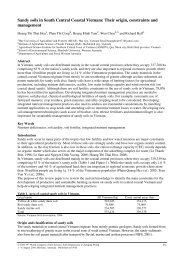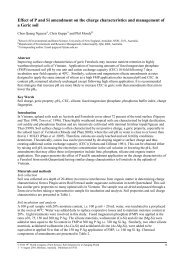Rab Abdur - International Union of Soil Sciences
Rab Abdur - International Union of Soil Sciences
Rab Abdur - International Union of Soil Sciences
You also want an ePaper? Increase the reach of your titles
YUMPU automatically turns print PDFs into web optimized ePapers that Google loves.
The relationships between clay content and FC and PWP found in this study are consistent with those<br />
reported for other soils (e.g. King and Stark 2005; Minasny et al. 1999; Iqbal et al. 2005). For example, Iqbal<br />
et al. (2005) found greater values <strong>of</strong> volumetric water content at paddock locations where the percentage clay<br />
content was high; an indication <strong>of</strong> the greater water holding capacity <strong>of</strong> soil micropores between clay-sized<br />
particles. Minasny et al. (1999) found a positive non-linear relationship between clay content and FC and<br />
PWP. The equations developed in this study can be used to predict FC and PWP for similar soil types. These<br />
samples used in this study (N=72) cover a wide range in soil textural composition but limited range in<br />
organic carbon content. Therefore, further research, covering wide range <strong>of</strong> landuse systems, soil types and<br />
climatic conditions, is required to improve these predictive equations.<br />
Conclusions<br />
FC, PWP and PAWC were found to be significantly higher for GV followed by HYC and RS. FC was<br />
affected by both clay content and organic carbon (OC) content but PWP was only affected by clay content<br />
but not by OC. The developed equations can be used to predict FC and PWP for similar soils elsewhere.<br />
However, further research is needed to validate/improve the predictive models for a wider range <strong>of</strong> organic<br />
carbon content, soil types, soil texture and climatic conditions.<br />
Acknowledgement<br />
This research was jointly funded the Grains Research and Development Corporation and the Victorian<br />
Department <strong>of</strong> Primary Industries. The authors would like to thank A. Weidemann, I. McLelland, M.<br />
McLelland and R. Dunlop for the use <strong>of</strong> their paddocks.<br />
References<br />
Better <strong>Soil</strong>s (2005) Better <strong>Soil</strong>s. Module 5: Managing soil moisture, 5.1 <strong>Soil</strong> Water Holding Capacity.<br />
http://www.bettersoils.com.au/module5/5_1.htm<br />
Cock GJ (1985) Moisture characteristics <strong>of</strong> irrigated Mallee soils in South Australia. Australian Journal <strong>of</strong><br />
Experimental Agriculture 25, 209-13<br />
Hochman Z, Dalgliesh NP, Bell KL (2001) Contribution <strong>of</strong> soil and crop factors to plant available soil water<br />
capacity <strong>of</strong> annual crops on Black and Grey Vertosols. Australian Journal <strong>of</strong> <strong>Soil</strong> Research 52, 955 -<br />
961.<br />
Iqbal J, Read JJ, Thomasson AJ, Jenkins JN (2005) Relationships between <strong>Soil</strong>–Landscape and Dryland<br />
Cotton Lint Yield. <strong>Soil</strong> Science Society <strong>of</strong> American Journal 69, 872-882.<br />
Isbell RF (2002) ‘The Australian <strong>Soil</strong> Classification.’ (CSRIO Publishing: Collingwood, Vic.)<br />
Jensen ME, Burman RD, Allen RG (1990) Evapotranspiration and Irrigation Water Requirements. ASCE<br />
Manuals and Reports on Engineering Practice No. 70. American Society <strong>of</strong> Civil Engineers, New<br />
York, NY.<br />
Keating BA, Carberry PS, Hammer GL, Probert ME, Robertson MJ, Holzworth D, Huth NI, Hargreaves<br />
JNG, Meinke H, Hochman Z, McLean G, Verburg K, Snow V, Dimes JP, Silburn M, Wang E, Brown<br />
S, Bristow KL, Asseng S, Chapman S, McCown RL, Freebairn DM, Smith CJ (2003) An overview <strong>of</strong><br />
APSIM, a model designed for farming systems simulation. European Journal <strong>of</strong> Agronomy 18, 267-<br />
288.<br />
King BA, Stark JC (2005) Spatial variability considerations in interpreting soil moisture measurements for<br />
irrigation scheduling. http://info.ag.uidaho.edu/pdf/BUL/BUL0837.pdf<br />
Minasny B, McBratney AB, Bristow KL (1999) Comparison <strong>of</strong> different approaches to the development <strong>of</strong><br />
pedotransfer functions for water-retention curves. Geoderma 93, 225–253.<br />
Murphy SR, Lodge GM (2001) <strong>Soil</strong> water characteristics <strong>of</strong> a red chromosol and brown vertosol and pasture<br />
growth. Proceedings <strong>of</strong> the 10th Australian Agronomy Conference, Hobart, 2001.<br />
http://www.regional.org.au/au/asa/2001/2/b/murphy1.htm?print=1<br />
Payne RW, Harding SA, Murray DA, Soutar DM, Baird DB, Welham SJ, Kane AF, Gilmour AR, Thomson<br />
R, Webster R, Wilson GT (2007) ‘The Guide to GenStat, Release 10. Part 2: Statistics.’ (VSN<br />
<strong>International</strong>, Hertfordshire, UK).<br />
<strong>Rab</strong> MA, Fisher PD, Armstrong RD, Abuzar M, Robinson NJ, Chandra S (2009) Advances in precision<br />
agriculture in south-eastern Australia. IV. Spatial variability in plant-available water capacity <strong>of</strong> soil<br />
and its relationship with yield in site-specific management zones. Crops and Pastures 60, 885-900.<br />
Ratliff LF, Ritchie JT, Cassel DK (1983) A survey <strong>of</strong> field-measured limits <strong>of</strong> soil water availability and<br />
related to laboratory-measured properties. <strong>Soil</strong> Science Society <strong>of</strong> America Journal 47, 770–775.<br />
© 2010 19 th World Congress <strong>of</strong> <strong>Soil</strong> Science, <strong>Soil</strong> Solutions for a Changing World<br />
1 – 6 August 2010, Brisbane, Australia. Published on DVD.<br />
136



